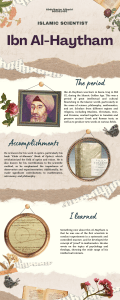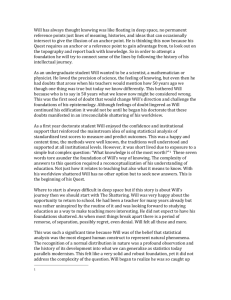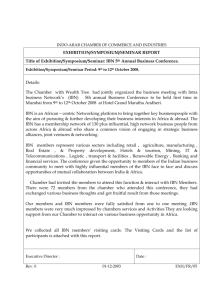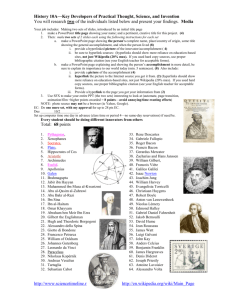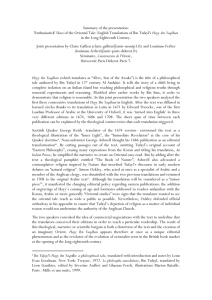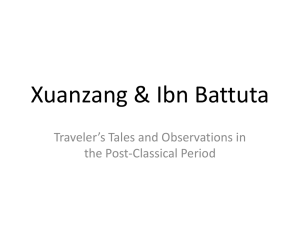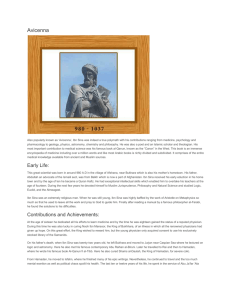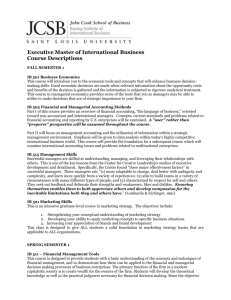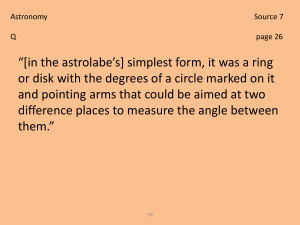Jim-Al-Khalili-Edinburgh-May-2012
advertisement
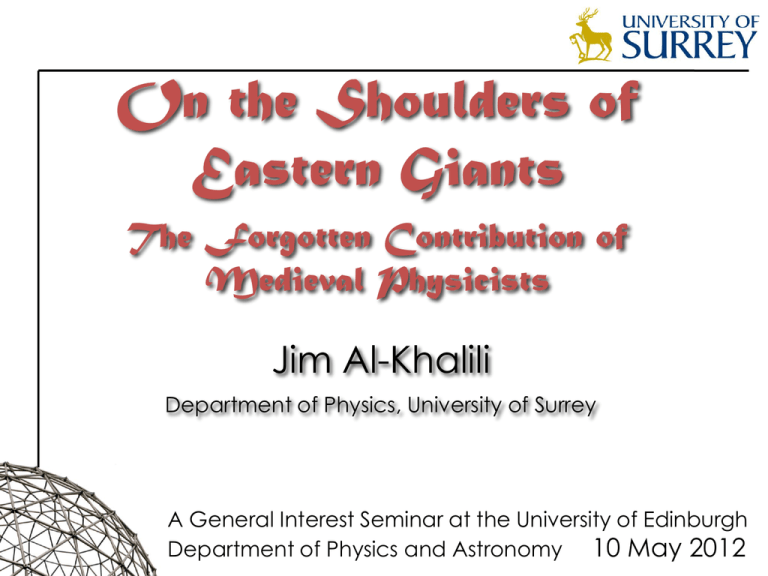
On the Shoulders of Eastern Giants The Forgotten Contribution of Medieval Physicists Jim Al-Khalili Department of Physics, University of Surrey A General Interest Seminar at the University of Edinburgh Department of Physics and Astronomy 10 May 2012 Nathaniel Schmidt, Ibn Khaldun: Historian, Sociologist and Philosopher (New York: AMS Press, Inc., 1967) Source: Jacob Lassner, Journal of the Economic and Social History of the Orient, Vol. 9, (1966) p.1 Abbasid Caliph Harun al-Rashid and king Charlemagne Oil painting Julius Koeckert (1827-1918), dated 1864, Maximilianeum Foundation, Munich Al-Mamun built a new academy: Bayt al-Hikma “The House of Wisdom” Indian numerals 6 x x x 10 3 x x x 11 10 10 10 x x 10 10 10 10 x In this case, x = 135 179.685 The Babylonians and early algebra A typical problem might have been: Find the number if, when added to its reciprocal, equals a known number. This is an example of a quadratic equation: Solved using ‘formula method’ we all learn at school. But this is not what we regard as real algebra. They did not regard the unknown (x) as an object in itself, but merely solved specific problems (instead of developing general algebraic rules). 9 Algebra or number theory? Diophantus, wrote Arithmetica and pioneered class of equations involving two or more unknown quantities raised to any power, such that solutions always integers (Diophantine equations) Brahmagupta studied particular Diophantine equation –the ‘Pell equation’, which has the general form He posed the challenge of finding a solution if a =92. He suggested that anyone who could solve this problem within a year earned the right to be called a mathematician. Today, this is easy. We have computers!! 10 Al-Biruni (973–1048) Persian polymath, regarded as the Da Vinci of the medieval world. First Biruni measured the height of a mountain (in Pakistan) He then climbed to the top of the mountain and measured the angle of dip to the horizon. Φ R+h R Φ If we know h and Φ then we can find R. Origin of ‘sine’ Robert of Chester in 12th century gave us the word sine, but how did we get this from the Hindus? Etymologically, we must begin with the Sanskrit word jya-ardha, which means ‘half the bowstring’ (or, geometrically, half the chord of a circle). Jya-ardha abbreviated to jiva, transliterated in Arabic as jiba. When translated to Latin, mistaken to say jayb (‘pocket’). Latin for pocket is sinus Hence sine. Greatest Physicists in History Archimedes 3rd c. BCE Ibn al-Haytham 11th century Span of two thousand years Isaac Newton 17th century Alhazen’s problem In optics. Latinized first name of ibn alHaytham: Al-Hassan Requires a quartic equation Solution using conical sections Conic Sections From Ibn Sahl’s On The Burning Instruments (984 AD) Six centuries before Willebrord Snell wrote down his law of refraction Was Copernicus first to propose heliocentric model? No, first proposed by Greek philosopher, Aristarchus (3rd c. BCE); No one believed him (apart from a lone Babylonian called Seleucus ); Indian astronomers heliocentric model Archimedes, wrote:proposed "You know that most Arab astronomer al-Sijzi (c. also proposed astronomers designate by945-1020) the word cosmos the heliocentric model and was supported by al-Biruni. sphere whose centre coincides with the centre of the earth... But Artistarchus … assumes that the Just like these astronomers, Copernicus fixed stars andearlier the sun remain stationary, whilewas courageous… the earth moves round the sun through the circumference of a circle.” But, like them, he was just guessing! On the other hand, he did turn a philosophical idea into a fully predictive mathematical theory. Copernicus (1543) Tusi (1261) Galileo Galilei (1564-1642) The theoretician and the experimentalist Ibn al-Haytham and Galileo on the frontispiece of Selenographia, a 1647 description of the moon by Johannes Hevelius Ibn al-Haytham can and should also be regarded as first person to define the ‘scientific method’: “We should destinguish the properties of particulars, and gather by induction what pertains to the eye to be uniform, unchanging, manifest and not subject to doubt. After which we should assend in our enquiry and reasoning, gradually and orderly, criticizing premises and exercising caution in regard to conclusions – our aim in all that we make subject to inspection and review being to employ justice, not to follow prejudice, and to take care in all that we judge and criticize that we seek the truth and not be swayed by opinion.” Mathematical advances in Muslim world continued into 15th century. Jamshid al-Kashi (1380-1429) in Samarkand • Calculated pi to 16 decimal places a c θ b • Gave us the ‘Cosine Rule’ In France this is still known as théorème d’al-Kashi When it comes to understanding our world through reason AND experimentation… “The Greeks systematised, generalised and theorised, but the patient ways of investigation, the accumulation of positive knowledge, the minute methods of science, detailed and prolonged observation and experimental enquiry, were altogether alien to the Greeks’ temperament… What we call science arose in Europe as a result of a new spirit of enquiry… of the methods of experiment, observation and measurement, of the development of mathematics in a form unknown to the Greeks. That spirit and those methods were introduced into the European world by the Arabs.” Robert Briffault, The Making of Humanity (1930)
